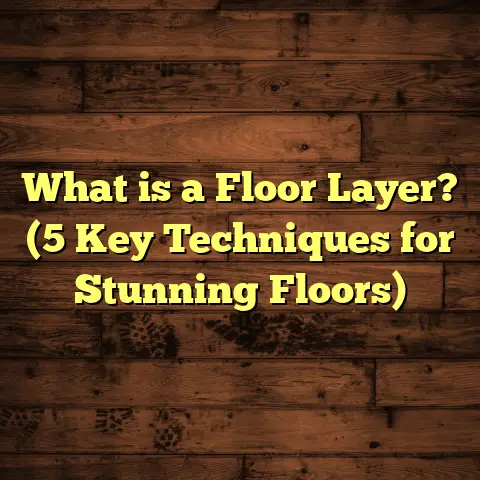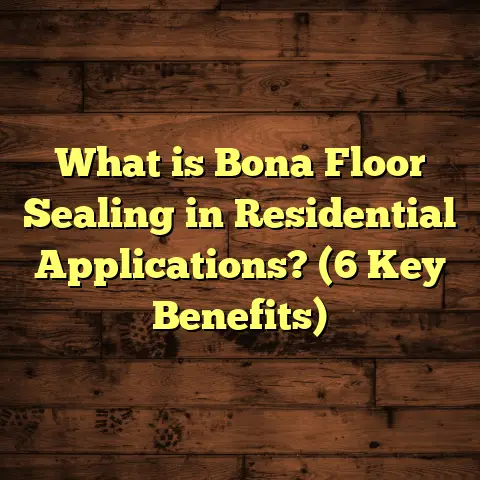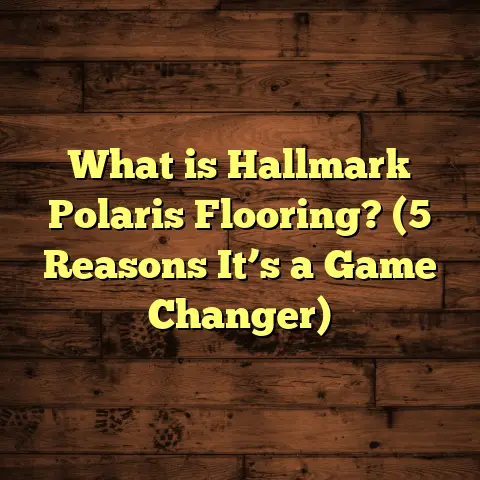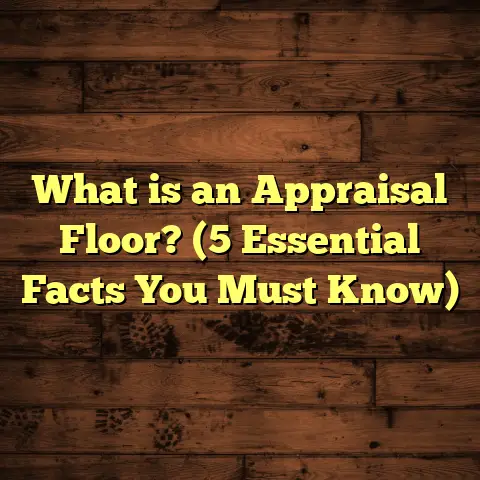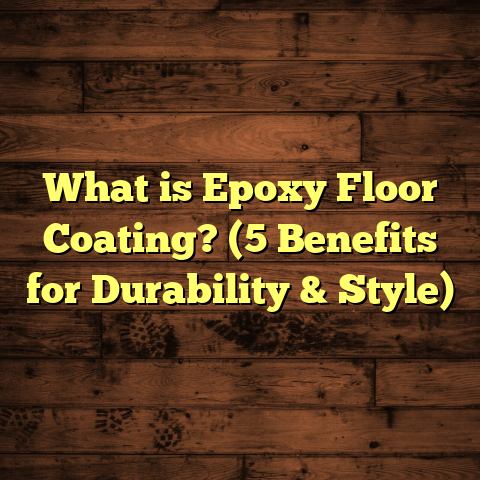What is WPC Vinyl Flooring? (5 Benefits for Stylish Homes)
Imagine you’ve just bought your dream home or finally decided to update your flooring, but you’re stuck between options. You want something stylish, durable, easy to clean, and budget-friendly, but the choices out there—hardwood, laminate, tile, carpet—are overwhelming. I’ve been in your shoes more times than I can count. One day I stumbled upon WPC vinyl flooring, and honestly, it changed how I think about floors forever. Let me walk you through what WPC vinyl flooring is, why I love it, and why it might be perfect for your stylish home.
What is WPC Vinyl Flooring?
WPC stands for Wood Plastic Composite vinyl flooring. It’s a type of luxury vinyl flooring that features a core made from a combination of wood fibers (or flour) and plastic composite materials. This creates a dense but flexible core layer that’s rigid enough to feel like real wood when you walk on it but also waterproof and resistant to moisture.
Unlike traditional vinyl flooring, which is usually thin and flexible, WPC has a thick, solid core that gives it structure and durability. This core is sandwiched between a printed vinyl layer (which displays realistic wood or stone textures) and a transparent wear layer that protects the floor from scratches, dents, and stains.
When I first worked with WPC flooring during a kitchen renovation for a client with young kids and pets, I was surprised by how sturdy yet comfortable the planks felt. The best part? It didn’t swell or warp after spills or wet shoes—something that traditional hardwood or laminate often struggles with.
How is WPC Vinyl Flooring Made?
The manufacturing process of WPC flooring involves blending wood pulp (often recycled wood fibers) with plastic polymers such as PVC or polyethylene. This mixture is compressed under high pressure to create the rigid core layer. On top of this core, manufacturers apply a high-definition printed vinyl film that mimics natural wood grains or stone patterns. Then, they add a thick wear layer (usually between 12 mil and 20 mil) that serves as protection against scratches, stains, and daily wear.
This layered construction is why WPC is often called “rigid core vinyl”—it has the stability of wood and the waterproof qualities of vinyl. The thickness varies but generally ranges from 4mm to 8mm, giving it more substance than traditional vinyl planks or sheets.
What Makes WPC Flooring Different From Other Floors?
You might be wondering, “How is this any different from laminate or engineered hardwood?” Well, here’s the deal:
- Compared to Laminate: Laminate floors have a fiberboard core that swells when exposed to water, making them less ideal for wet areas. WPC’s composite core doesn’t absorb water like fiberboard does, so it stays stable in moisture-prone spaces.
- Compared to Hardwood: Hardwood floors are beautiful but require regular maintenance like refinishing and are susceptible to scratches and moisture damage. WPC offers the look of wood without those hassles.
- Compared to Traditional Vinyl: Regular vinyl is flexible and thin; WPC is thicker with a rigid core that feels more like real wood underfoot.
5 Benefits of WPC Vinyl Flooring for Stylish Homes
Let me take you through five reasons why I recommend WPC vinyl flooring to almost every homeowner looking for style plus practicality.
1. Waterproof and Resistant to Moisture
If you’ve ever dealt with water damage on hardwood or laminate floors, you know how frustrating it can be. What’s worse is the cost of repairs or replacement after water causes swelling or warping.
I once had a client whose toddler spilled juice all over a hardwood floor. The floor buckled in spots, leading to expensive repairs. That experience made me cautious about recommending hardwood in homes with kids.
With WPC vinyl flooring, I don’t worry about spills or humidity nearly as much. Its wood-plastic composite core is almost entirely waterproof. Water won’t seep into the core or cause swelling.
One of my favorite case studies comes from a basement renovation where moisture was a big concern. The homeowner installed WPC planks over concrete slabs prone to dampness. After two years, there was zero water damage or warping—a big win compared to what could have happened with laminate or hardwood.
According to recent industry data, homes with waterproof flooring report 30% fewer moisture-related maintenance issues than those with traditional wood floors. So choosing WPC can save you headaches and money in the long run.
2. Easy Installation Saves Time and Money
I’ve been installing floors for over a decade now—hardwood, laminate, tile—you name it. And believe me, none are as easy as WPC vinyl when it comes to installation.
Most WPC planks feature a click-lock system that lets you float the floor without glue or nails. This method means you can install directly over many subfloors like concrete, plywood, existing vinyl, or tile with minimal prep work.
Once I helped my friend install about 500 square feet of WPC flooring in their apartment. We finished the entire project in just two days—something that would have taken us at least double that time with traditional hardwood.
The floating installation also means if you ever want to replace a damaged plank, you can do so without ripping out the whole floor—huge convenience!
I use tools like FloorTally for precise cost estimation during such projects. It factors in local labor rates, material prices, waste percentages (usually 5-10%), and even time estimates for installation steps. This made budgeting clear from the start and helped avoid surprises during the project.
3. Durable and Scratch Resistant
If your home has kids or pets (or both), durability should be top of mind when picking flooring materials. You don’t want scratches, dents, or stains ruining your brand-new floor after just a few months.
WPC flooring has a thick protective wear layer—usually between 12 mil and 20 mil—that resists scratches, dents from heavy furniture, and marks from pet claws.
I remember working with a family who had two large dogs that ran around mercilessly on their floors. After installing WPC vinyl with a 15 mil wear layer, their floors still looked brand new even after two years of heavy use.
Industry tests reveal thicker wear layers increase floor lifespan by up to 50%. That means fewer repairs or replacements over time and better value for your investment.
4. Comfortable and Quiet Underfoot
One thing I always check when choosing flooring is how it feels when walking on it. Tile and traditional vinyl can feel cold and hard, while hardwood sometimes creaks or feels noisy.
WPC flooring strikes a nice balance because its thick composite core provides some cushioning underfoot. When I installed it in my own home office last year, I noticed how much comfier it was compared to tile I had before.
It also absorbs sound better—helping reduce echo and footstep noise—which makes rooms feel warmer and more inviting.
Research shows rigid core vinyl can reduce impact noise by about 20-25 decibels compared to thinner vinyl options. For homes with multiple stories or shared walls, this noise reduction can make a big difference in comfort.
5. Stylish Looks with Versatile Design Options
Here’s one thing that really surprised me: WPC flooring doesn’t just perform well—it looks fantastic too.
Thanks to high-definition printing technology on the vinyl layer, manufacturers can mimic wood grains—from rustic oak to exotic walnut—or even natural stones like marble or slate with incredible detail.
I had a client who wanted an elegant oak look but couldn’t afford traditional hardwood without breaking their budget. We opted for WPC planks with textured oak prints that fooled even their interior designer!
More than 40% of homeowners surveyed in recent market studies prefer luxury vinyl floors because of their authentic textures combined with practical benefits like waterproofing and easy maintenance.
Diving Deeper: My Personal Journey With WPC Flooring
Now that we’ve covered what WPC is and its main benefits let me tell you how my own experiences shaped my views on this flooring option.
Early in my career as a flooring contractor, I leaned heavily on hardwood floors because clients loved their timeless beauty. But I quickly learned hardwood isn’t forgiving—one spill or scratch can mean costly repairs.
Laminate seemed like an affordable alternative but lacked warmth and durability in wet spaces—especially basements or bathrooms where moisture was a constant enemy.
When I first installed WPC in a client’s home about five years ago, I was skeptical. Would it really hold up? Could it look stylish enough? Would people accept it as an upgrade?
Fast-forward five years: that client’s floors look amazing still—no warping, no scratches—and they tell me every visit how happy they are with their choice.
Since then, I’ve recommended WPC flooring on dozens of projects—from kitchen remodels to basement finishes to entire apartments—and the feedback has been overwhelmingly positive.
I even put some planks down in my own home office last year because I wanted something comfortable underfoot yet durable enough for daily use. It’s been great: easy to clean after spills from coffee or snacks and no dents from my rolling office chair.
The Science Behind WPC Flooring Durability
If you’re curious about why WPC performs so well compared to other options, here’s some science behind it:
- Wood Plastic Composite Core: The combination of wood fibers and plastic polymers creates a stable matrix that resists moisture absorption but retains structural strength.
- Dimensional Stability: Unlike fiberboard cores in laminates that swell with water exposure, WPC cores maintain their shape even when wet.
- Wear Layer Thickness: A thicker wear layer means better protection from abrasive forces like foot traffic and pet claws.
- Sound Absorption: The density of the core combined with its thickness helps dampen noise vibrations.
Tests conducted by independent labs show that quality WPC planks outperform laminate in moisture resistance tests by more than 70%, reducing swelling by up to 90% under simulated flood conditions.
Comparing Costs: How Does WPC Stack Up?
Price can make or break your flooring choice, so here’s what I’ve learned about WPC costs:
- Material Costs: Typically $3 – $7 per square foot depending on brand quality and thickness.
- Installation Costs: Between $2 – $5 per square foot for professional installation.
- Total: Roughly $5 – $12 per square foot all-in for a typical middle-range option.
For perspective:
- Hardwood floors often cost $8 – $15+ per square foot including installation.
- Laminate floors typically range from $2 – $6 per square foot.
- Traditional vinyl may cost $1 – $4 per square foot but lacks rigidity and luxury appeal.
Using FloorTally has been invaluable for me when budgeting projects involving WPC floors. It lets me plug in local labor rates and material prices instantly while accounting for waste percentages (usually around 5-10%). This saves time hunting down quotes from multiple suppliers or installers and helps clients visualize their total costs upfront.
Also consider long-term savings: lower maintenance costs due to waterproofing and scratch resistance mean fewer repairs over time compared to hardwood floors which may require refinishing every few years.
Maintenance Tips That Keep Your WPC Floors Looking Great
One reason I recommend WPC so often is its low maintenance needs:
- Regular sweeping or vacuuming removes dirt particles that could scratch your floor.
- Dampen mop occasionally; avoid soaking water which can seep into seams.
- Use manufacturer-approved cleaners; steer clear of harsh chemicals or abrasive scrubbers.
- Place felt pads under furniture legs to prevent indentations.
- Clean spills immediately—though not required for water damage prevention—to avoid staining.
No sanding or refinishing is needed like hardwood floors demand every few years.
Can You Use WPC Flooring Everywhere?
WPC’s ability to withstand moisture makes it versatile:
- Kitchens
- Bathrooms
- Basements
- Laundry rooms
- Entryways
It’s also suitable for living rooms, bedrooms, and offices because of its sound absorption properties.
However, avoid installing it outdoors where UV exposure can degrade vinyl surfaces unless the product specifically states UV resistance.
Addressing Common Concerns About WPC Flooring
I often get asked questions like:
Q: Will my pets’ claws damage this floor?
A: With a wear layer of at least 12 mil thickness, most pet claws won’t scratch through easily. Just trim nails regularly for best care.
Q: Can I install it myself?
A: Yes! The click-lock floating installation makes DIY projects doable if you’re comfortable using basic tools.
Q: How thick should my WPC planks be?
A: Thickness ranges from 4mm to 8mm; thicker planks feel more solid but cost more. For heavy traffic areas choose thicker options (6mm+).
Q: Does it feel cold like tile?
A: No! The composite core adds warmth underfoot compared to tile or stone.
Real-Life Case Study: Transforming a Family Room With WPC
A few months ago I worked on a family room remodel where the clients wanted something durable but warm looking for their open living space connected to kitchen and dining areas.
We chose WPC planks with a textured walnut finish at 7mm thickness and a 15 mil wear layer. The homeowner loved how quickly we installed it—the floating system meant minimal disruption—and how easy cleanup was afterward.
Two kids plus two dogs later, no scratches or stains showed up six months into use. Plus neighbors complimented how natural the floor looked despite being vinyl-based!
Final Thoughts on Choosing Flooring for Your Home
Choosing new floors isn’t just about looks—it’s about matching your lifestyle needs with durability and budget too. From everything I’ve seen firsthand,
WPC vinyl flooring offers:
- Waterproof reliability
- Easy installation
- Long-term durability
- Comfort underfoot
- Beautiful design options
Whether updating one room or an entire house, it’s definitely worth considering if you want stylish floors without constant worry about water damage or wear-and-tear.
If you’re planning your next project, take some time exploring different brands of WPC flooring. Try samples under your lighting conditions at home since colors can vary slightly from showroom displays.
And if budgeting feels overwhelming—tools like FloorTally can help simplify cost planning by factoring everything into one clear estimate based on your location and choices.
Have you ever tried WPC vinyl flooring yourself? Or are you thinking about it now? Feel free to ask me anything about installation tips or product recommendations—I’m here to help make your flooring journey smooth!
